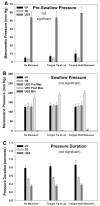Evaluating the tongue-hold maneuver using high-resolution manometry and electromyography
- PMID: 24969727
- PMCID: PMC4179981
- DOI: 10.1007/s00455-014-9545-6
Evaluating the tongue-hold maneuver using high-resolution manometry and electromyography
Erratum in
- Dysphagia. 2014 Oct;29(5):571. Jones, Corrine A [corrected to Jones, Corinne A]
Abstract
The tongue-hold maneuver is a widely used clinical technique designed to increase posterior pharyngeal wall movement in individuals with dysphagia. It is hypothesized that the tongue-hold maneuver results in increased contraction of the superior pharyngeal constrictor. However, an electromyographic study of the pharynx and tongue during the tongue-hold is still needed to understand whether and how swallow muscle activity and pressure may change with this maneuver. We tested eight healthy young participants using simultaneous intramuscular electromyography with high-resolution manometry during three task conditions including (a) saliva swallow without maneuver, (b) saliva swallow with the tongue tip at the lip, and (c) saliva swallow during the tongue-hold maneuver. We tested the hypothesis that tongue and pharyngeal muscle activity would increase during the experimental tasks, but that pharyngeal pressure would remain relatively unchanged. We found that the pre-swallow magnitude of tongue, pharyngeal constrictor, and cricopharyngeus muscle activity increased. During the swallow, the magnitude and duration of tongue and pharyngeal constrictor muscle activity each increased. However, manometric pressures and durations remained unchanged. These results suggest that increased superior pharyngeal constrictor activity may serve to maintain relatively stable pharyngeal pressures in the absence of posterior tongue movement. Thus, the tongue-hold maneuver may be a relatively simple but robust example of how the medullary swallow center is equipped to dynamically coordinate actions between tongue and pharynx. Our findings emphasize the need for combined modality swallow assessment to include high-resolution manometry and intramuscular electromyography to evaluate the potential benefit of the tongue-hold maneuver for clinical populations.
Figures





Similar articles
-
Effect of Tongue-Hold Swallow on Pharyngeal Contractile Properties in Healthy Individuals.Dysphagia. 2021 Oct;36(5):936-943. doi: 10.1007/s00455-020-10217-9. Epub 2021 Jan 1. Dysphagia. 2021. PMID: 33386483 Free PMC article.
-
An analysis of lingual contribution to submental surface electromyographic measures and pharyngeal pressure during effortful swallow.Arch Phys Med Rehabil. 2006 Aug;87(8):1067-72. doi: 10.1016/j.apmr.2006.04.019. Arch Phys Med Rehabil. 2006. PMID: 16876551
-
Effect of Visual Biofeedback Obtained Using the Iowa Oral Performance Instrument on the Suprahyoid Muscle Activation Level During Effortful Swallowing Maneuver.Dysphagia. 2024 Jun;39(3):433-443. doi: 10.1007/s00455-023-10627-5. Epub 2023 Nov 7. Dysphagia. 2024. PMID: 37936019
-
High-resolution manometry: what about the pharynx?Curr Opin Otolaryngol Head Neck Surg. 2018 Dec;26(6):382-391. doi: 10.1097/MOO.0000000000000491. Curr Opin Otolaryngol Head Neck Surg. 2018. PMID: 30234661 Review.
-
Modern solid state computerized manometry of the pharyngoesophageal segment.Dysphagia. 1993;8(3):270-5. doi: 10.1007/BF01354550. Dysphagia. 1993. PMID: 8359050 Review.
Cited by
-
An intensive swallowing exercise protocol for improving swallowing physiology in older adults with radiographically confirmed dysphagia.Clin Interv Aging. 2019 Feb 11;14:283-288. doi: 10.2147/CIA.S194723. eCollection 2019. Clin Interv Aging. 2019. PMID: 30804667 Free PMC article.
-
Effect of Tongue-Hold Swallow on Laryngeal Elevation During Swallowing in Healthy Older Men.Cureus. 2024 Aug 30;16(8):e68245. doi: 10.7759/cureus.68245. eCollection 2024 Aug. Cureus. 2024. PMID: 39347353 Free PMC article.
-
Derivation and measurement consistency of a novel biofluid dynamics measure of deglutitive bolus-driving function-pharyngeal swallowing power.Neurogastroenterol Motil. 2019 Jan;31(1):e13465. doi: 10.1111/nmo.13465. Epub 2018 Sep 23. Neurogastroenterol Motil. 2019. PMID: 30246422 Free PMC article.
-
High-Resolution Pharyngeal Manometry and Impedance: Protocols and Metrics-Recommendations of a High-Resolution Pharyngeal Manometry International Working Group.Dysphagia. 2020 Apr;35(2):281-295. doi: 10.1007/s00455-019-10023-y. Epub 2019 Jun 5. Dysphagia. 2020. PMID: 31168756 Review.
-
Comparison of unidirectional and circumferential manometric measures within the pharyngoesophageal segment: an exploratory study.Eur Arch Otorhinolaryngol. 2018 Sep;275(9):2303-2310. doi: 10.1007/s00405-018-5019-z. Epub 2018 Jun 26. Eur Arch Otorhinolaryngol. 2018. PMID: 29946881
References
-
- Fujiu M, Logemann JA. Effect of a tongue-holding maneuver on posterior pharyngeal wall movement during deglutition. Am J Speech Lang Pathol. 1996;5:23–30.
-
- Kokawa T, Saigusa H, Aino I, Matsuoka C, Nakamura T, Tanuma K, Yamashita K, Niimi S. Physiological studies of retrusive movements of the human tongue. J Voice. 2006;20:414–22. doi:10.1016/j. jvoice.2005.08.004. - PubMed
-
- Saigusa H, Yamashita K, Tanuma K, Saigusa M, Niimi S. Morphological studies for retrusive movement of the human adult tongue. Clin Anat. 2004;17:93–8. doi:10.1002/ca.10156. - PubMed
-
- Zemlin WR. Speech and hearing science: anatomy and physiology. 3rd ed. Prentice Hall; Englewood Cliffs: 1988.
-
- Takemoto H. Morphological analyses of the human tongue musculature for three-dimensional modeling. J Speech Lang Hear Res. 2001;44:95–107. - PubMed
Publication types
MeSH terms
Grants and funding
LinkOut - more resources
Full Text Sources
Other Literature Sources

